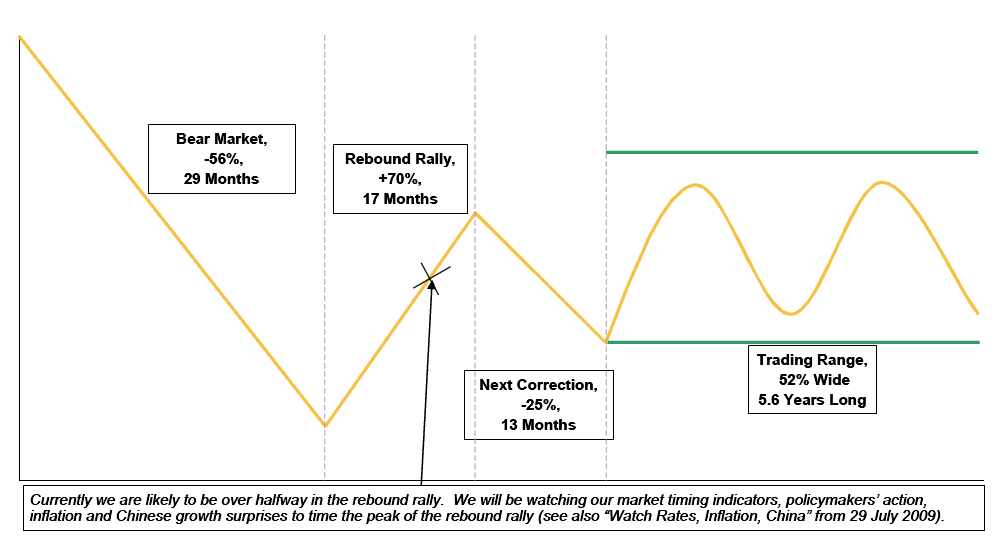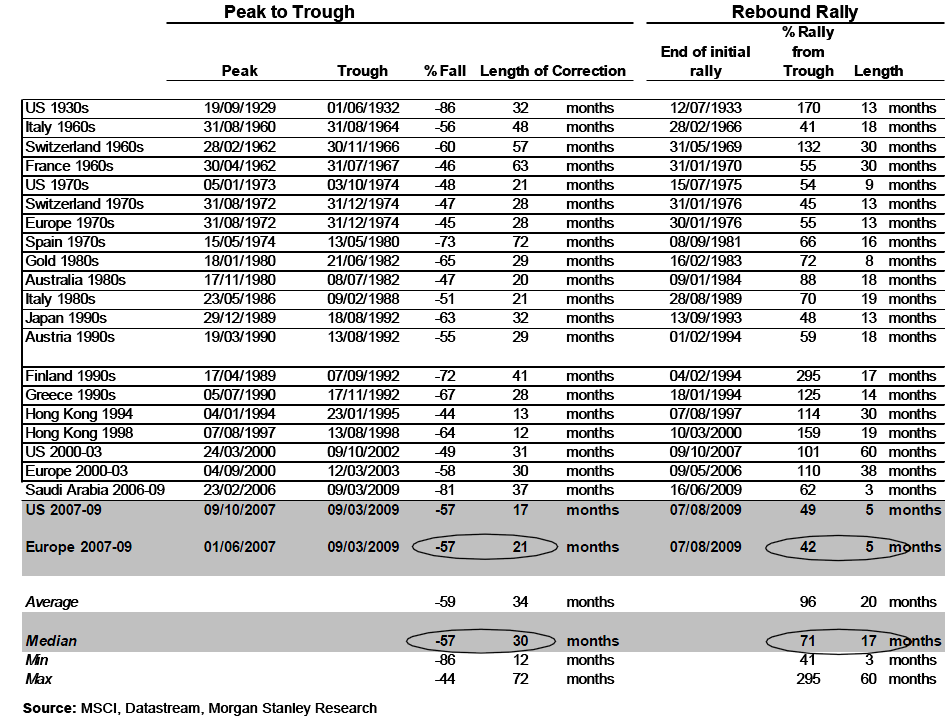Aug. 5 (Bloomberg) -- The world’s biggest debt investors say the steepest rally in the riskiest corporate bonds may be poised to fall apart.
Bonds with CCC ratings and the greatest risk of failure to make payments have gained 80 percent since March 9. The high- yield market is trading as if 7.94 percent of all issues will default over the next year, about 1.44 percentage point less than the actual rate since July 2008, according to Fridson Investment Advisors and Standard & Poor’s.
With the U.S. in its longest recession in seven decades, the riskiest bonds are soaring more than the Nasdaq Composite Index did in the five months before the dot-com bubble burst in March 2000. Debt of Austin, Texas-based Freescale Semiconductor Inc., which posted a record $7.39 billion loss last year, has jumped more than 800 percent since Feb. 27. Notes issued by Rite Aid Corp., the drugstore chain that hasn’t had a profit in two years, rose fourfold since March 9.
“It’s very difficult for some of these companies to survive with that wide a gap between their profit rate and their financing costs,” Mark Kiesel, global head of corporate bond portfolios at Pacific Investment Management Co., said in an interview from Newport Beach, California.
S&P forecasts a 13.9 percent default rate a year from now, or as high as 18 percent if economic conditions worsen, while New York University professor Edward Altman, creator of the Z- score formula that calculates a company’s probability of bankruptcy, puts the figure at 12.8 percent.
Better Value
Investors should dispose of high-yield debt, rated below Baa3 by Moody’s Investors Service and BBB- by S&P, because defaults are climbing and investment-grade securities offer better value, said Kiesel, whose firm oversees the world’s largest bond fund.
The U.S. economic outlook also may not justify junk-bond prices, especially on the riskiest debt, said Elaine Stokes, who helps oversee $124 billion at Loomis Sayles & Co. in Boston.
Real gross domestic product will expand 2.1 percent next year after shrinking 2.5 percent in 2009, according to a Bloomberg survey of economists.
“A very rosy economic scenario is being priced in,” said Stokes, who co-manages the Loomis Sayles Bond Fund and has been cutting holdings of CCC rated securities.
“We definitely don’t feel now is the time to be chasing CCCs,” she said. Debt with that rating lost 38 percent last year, Merrill Lynch & Co. index data show.
While many high-yield debt issuers have reduced costs to survive the recession, the junk-bond rally is reminiscent of the run-up in technology stocks during the late 1990s, said Martin Fridson, chief executive officer of the New York-based credit investment firm that bears his name.
Satellite Bonds
The Nasdaq rose 75 percent from Oct. 8, 1999, to March 10, 2000, reaching a peak of 5,049. Within five weeks, the index lost about 34 percent of its value.
As high-yield debt prices increased, issuers rated CCC by S&P or Moody’s, such as Ford Motor Credit Co. and XM Satellite Radio Inc., have sold $5.55 billion of bonds since April 24, compared with $650 million in the previous six months, according to data compiled by Bloomberg.
The average price of CCC bonds climbed to a one-year high of 73.1 cents on the dollar Aug. 4 from a record-low 31.6 cents on Dec. 12, according to Merrill Lynch data.
That’s the fastest and sharpest recovery during a credit cycle on record, with prices 10 cents higher than at similar points during the last two recessions, Bank of America Corp. strategists Oleg Melentyev and Mike Cho in New York wrote in a July 23 report.
‘Very Optimistic’
Debt rated CCC will return an average of 1 percent during the coming five years, they wrote. That’s even under “very optimistic” assumptions of 22 percent of those issuers defaulting and a 20 percent to 30 percent recovery rate -- or amount of face value an investor can expect to receive after payment cessation.
The 1 percent gain would be “paltry compensation” for the securities’ risk and assumes an economic recovery as “optimistic as any V-shaped scenario could be,” Melentyev and Cho wrote.
Bonds rated CCC are “currently vulnerable to nonpayment” and “dependent upon favorable business, financial and economic conditions,” according to S&P.
‘Instant Shock’
Average yields on high-yield bonds fell to 8.88 percentage points over U.S. Treasuries as of Aug. 4 from a peak of 21.82 percentage points in December, according to Merrill Lynch data.
Spreads may widen by about 2 percentage points after August if there’s an “instant shock” or investors sell to “take profits,” John Fenn, a high-yield strategist at Citigroup Inc. in New York, said in an e-mail message. The securities would then likely rally again because “there’s plenty of money willing to chase the market,” he said.
In Europe, the yield premium investors demand to hold high- yield notes rather than similar-maturity government debt has about halved to 11.42 percentage points, from 22.63 on March 9, according to Merrill Lynch’s EMU Corporate Index. The securities have handed investors a record 53 percent return this year, assuming reinvested interest, Merrill data show.
CCC rated securities averaged a 40 percent annual default rate from 1999 to 2003, according to the Bank of America report. The U.S. went through the first recession in a decade from March to November 2001, according to the National Bureau of Economic Research in Cambridge, Massachusetts.
Freescale Semiconductor
Freescale Semiconductor, a supplier to automakers General Motors Corp. and Ford Motor Co., posted a fourth-straight quarterly sales decline and a loss of $481 million on July 23. Yet the company’s 9.125 percent notes due in 2014 rose 815 percent to 59.5 cents on the dollar from 6.5 cents on Feb. 27, according to Trace, the bond-price reporting system of the Financial Industry Regulatory Authority.
As of July 3, Freescale’s liabilities exceeded assets by $3.36 billion, according to the company. Blackstone Group LP and Carlyle Group led the acquisition of the company in a $17.6 billion private-equity transaction in 2006.
Freescale spokesman Andy North declined to comment.
Harrah’s Entertainment Inc.’s 6.5 percent notes due in 2016 have risen 690 percent to 41.5 cents on the dollar from 5.25 cents on Feb. 27, Trace data show. Excluding about $4.3 billion in gains from distressed debt exchanges and buybacks this year, the world’s biggest casino company hasn’t reported a profit in seven quarters.
Gambling Declines
Las Vegas-based Harrah’s was taken private by Leon Black’s Apollo Management LP and TPG Inc. for $30.7 billion in January 2008. Record gambling declines in Las Vegas and Atlantic City, New Jersey, the two biggest U.S. casino centers, led the company to report on July 24 that second-quarter revenue fell 13 percent.
Even after cutting debt, interest on Harrah’s more than $20 billion of long-term bonds and loans ate up 20 percent of revenue, according to the company.
Jacqueline Peterson, a Harrah’s spokeswoman, declined to comment in an e-mail message.
The rally in the lowest-rated bonds may be merited for companies such as Camp Hill, Pennsylvania-based Rite Aid that have trimmed staff, costs and inventories, said Robert Veno, an analyst at KDP Investment Advisors Inc., a high-yield research firm in Montpelier, Vermont.
‘Too Extreme’
“The original selloff going into March was too extreme,” Veno said in an interview. Now “people are giving them a lot of credit” for reducing costs.
Rite Aid’s 9.5 percent securities due in 2017 more than quadrupled to a 14-month high of 76.5 cents on the dollar from 18.9 cents on March 9, according to Trace. The third-largest U.S. drugstore chain has reported $4.12 billion of cumulative losses over the past eight quarters.
Karen Rugen, a Rite Aid spokeswoman, declined to comment.
Plunging high-yield bond prices earlier this year allowed companies including Freescale and Harrah’s to swap and buy back securities and loans at distressed prices, lowering debt and staving off default by pushing maturities into the future.
With signs of a thaw in credit markets, investors added $20.6 billion to speculative-grade bond funds through July 29, which exceeds any full-year total in at least eight years, according to Cambridge-based EPFR Global, which tracks $10 trillion in assets.
Economic Fundamentals
Some fund managers “are concerned that valuations may be running ahead of economic fundamentals,” Fridson wrote in a July 29 note. “But none of this appears to concern individual investors, who are pouring money into high-yield mutual funds at a prodigious rate.”
Fridson’s projection that the U.S. junk bond market priced in a 7.94 percent default rate as of July 31 was derived from the amount of bonds quoted at so-called distressed levels, which is when yields are 10 percentage points or more over benchmarks.
The 12-month trailing speculative-grade default rate is currently 9.38 percent, S&P said today. Moody’s forecasts the figure to peak at 12.9 percent in the fourth quarter before declining to 5 percent by July 2010.
The extra interest investors demand to own bonds with CCC ratings rather than Treasuries fell to 13.76 percentage points on Aug. 4, the lowest since Sept. 1, two weeks before Lehman Brothers Holdings Inc. collapsed. The record high was 44.29 percentage points on Dec. 15, according to Merrill Lynch data.
Recoveries on defaulted high-yield bonds averaged 21.8 percent in the first half of 2009, the lowest in at least a decade, according to Fitch Ratings in New York.
The flood of cash entering the speculative-grade market and looking for yield has made some investors “afraid to get out” in case prices keep going up, Stokes said.
“You go through periods like this where you’re much better off being a momentum guy, just jumping on the bandwagon and saying who cares whether they’re good value or not, they’re going higher,” said Fridson. “The fundamental people label that the bigger fool theory, and they tend to eventually get vindicated.”











